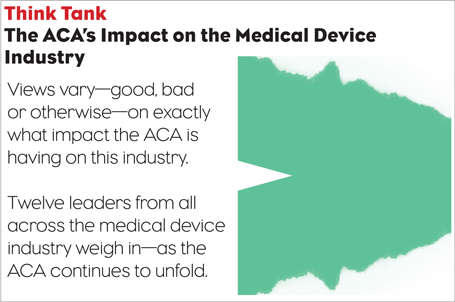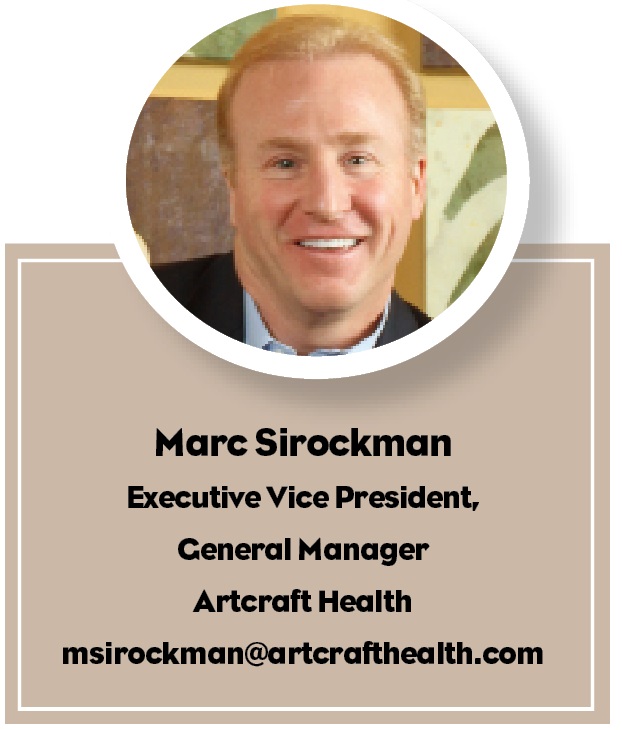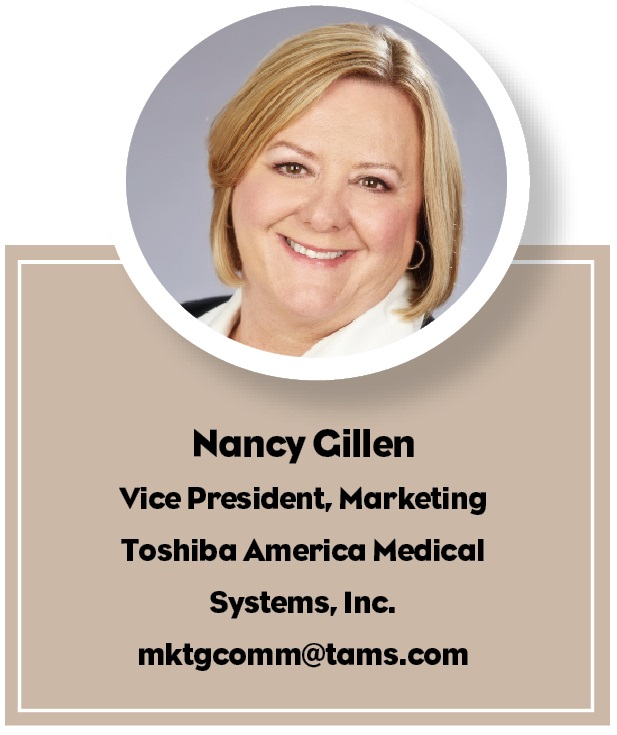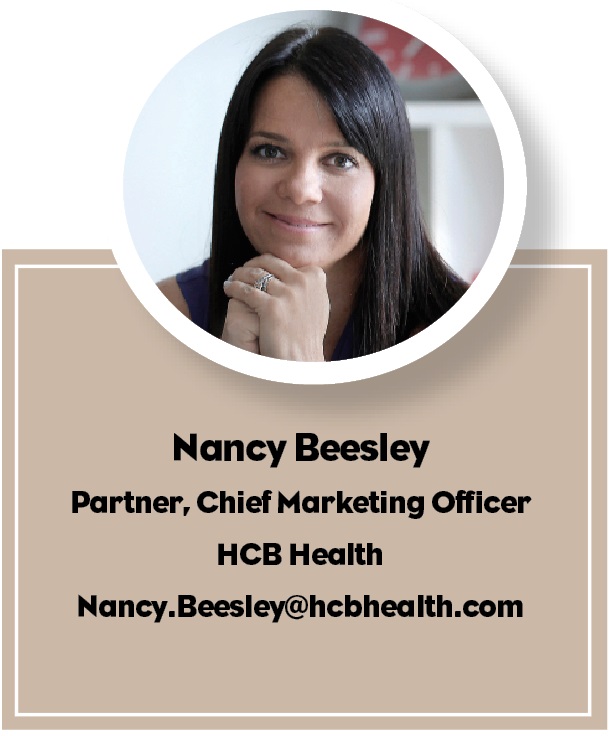Little more than four years ago, the Affordable Care Act (ACA) became law. As the healthcare industry continues to shift from a fee-for-service to a value-based business model, the medical device industry is shifting too. One much discussed example of this shift: The 2.3% Medical Device Excise Tax. But whether or not the resultant and continuing changes brought about by the ACA are moving the industry forward or backward is still up for debate.
To check the pulse of the industry, PM360 asked 12 leaders who work in or with the medical device business: How do you believe the Medical Device Excise Tax is affecting your industry? How will the ACA affect marketing budgets? Do you believe ACA requirements will lead to a greater consolidation of medical device companies? As the ACA continues to roll out, what future effects do you think could emerge?
The 2.3% device tax may not wipe out the entire device and diagnostics industry, but it damn sure isn’t helping! An online AdvaMed Member Survey conducted last December revealed some sobering consequences of the tax:
- 14,000 jobs were eliminated
- More than 30% of respondents reduced R&D spending
- Nearly 10% moved manufacturing operations out of the U.S.
Companies will look for ways to recapture these lost resources. The cost of doing business is only increasing with competition to attract talent, stricter compliance requirements, associated legal expenses and increasing FDA user fees.
But the real tragedy unfolding is the loss of opportunity. Many factors give rise to innovation, yet there is one common denominator—opportunity! As larger companies distribute the costs of the device tax, projects will be shelved. Mid-size companies will reduce headcount or abandon high-risk initiatives. Small companies will be hit hardest. As they grapple with new regulations, these entrepreneurs will find it increasingly difficult to bring a novel device to market. A promising device may simply shrivel on the vine if it cannot be nurtured and protected with precious resources.
Smaller companies take chances hiring people who may not have the ideal background. I’m blessed to have had that opportunity and to have worked in an environment where companies were incentivized to imagine what was possible.
Finally, a vital organ that experiences a 2.3% loss of healthy cells can trigger a cascade that permanently damages the organ. My hope is that policy makers will take note of the negative impacts of this device tax before the opportunity is gone.
When the government adds hoops for medical device companies to jump through, it causes administrative headaches and increases the cost of doing business, creating a documentation nightmare for vertically integrated companies that distribute and manufacture devices.
Companies selling devices directly to hospitals will be forced to revamp their accounting systems for tracking, controlling, and remitting the medical device excise tax, which can be costly. Companies will have to pay this tax whether they’re profitable or not.
When it’s harder for companies to be profitable, product innovation is squashed and the workforce is reduced. One of the ACA’s goals is to lower healthcare costs, but in the long run, I believe the ACA—combined with the administrative costs of the tax—will increase costs.
Yet manufacturers still need to make a profit. Marketing will always be in the budget; with the ACA, that amount may be smaller or remain static. Manufacturers will look to work with agencies that can stretch every marketing dollar without sacrificing quality.
Furthermore, health insurance will be more accessible, which means a greater influx of new patients, but likely decreased reimbursements for procedures and diagnostics. Marketing agencies will need to help their clients remain profitable and devise ways to manage the cost model based on lower fees with increased volume.
Marketing partners now have a unique opportunity to work with manufacturers on a macro level by providing paradigm-changing solutions that can drive greater demand and increase profits. We’ve seen device manufacturers opting to keep marketing functions in-house, utilizing graphics departments to produce marketing materials. As business becomes more complex, they may look to outside experts for help, providing agencies with more opportunities to demonstrate their value.
The 2.3% Medical Device Excise Tax is expected to bring $30 billion into government coffers over the next decade to help fund the ACA. It’s a big tax and, not surprisingly, it is being felt in big ways across the industry in companies large and small.
Specifically aimed at clinical medical devices sold to healthcare providers, such as stents and pacemakers, the tax has reportedly resulted in plant closings, employee layoffs, hiring and salary freezes, elimination of 401(k) matching programs, cuts in R&D, and business moves to overseas manufacturing. Additionally, pressures from the hospital industry make it difficult for these companies to pass on any of the tax, so many are forced to absorb it.
It’s impossible to gauge whether layoffs and other cost cutting measures are solely attributable to this tax. But the tax is significant and companies have to find ways to cover it. The ability of the influx of new patients to offset the new tax seems limited as many argue that new enrollees are young and have no need for these devices. So the device industry will bear the steep tax burden, but likely won’t reap any benefit.
Just as disturbing as the Medical Device Excise Tax is the impact it will have on innovation. According to the Advanced Medical Technology Association (AdvaMed), the majority of device companies have fewer than 100 employees. Many are young companies yet to make a profit that are now are saddled with paying this extra tax. And with larger medical technology companies cutting R&D budgets to control costs, the prospects for continued U.S. global medical device leadership are greatly diminished.
Thus, while clinical device manufacturers are paying the price today, it’s hard to ignore that the real impact will be on the evolution of patient care and our economy.
The Patient Protection and Affordable Care Act has created numerous challenges and opportunities for the medical device industry. It will bring new entrants into the healthcare system who are eager for education and treatment that may have been put off for years. In addition, federal healthcare reforms are expected to replace the traditional fee-for-service model with an outcomes-driven model.
Medical device companies will need to become much more strategic in all aspects of their business model. Traditional practices will be pushed to the wayside to focus on devices that are innovative and proven to stand the test of time. Hospitals will be reimbursed for “doing it right the first time” and increasing the focus on healthy outcomes.
The medical device industry will need to educate healthcare providers about efficiency, analytics and positive health outcome metrics to meet the new healthcare reform model. The solutions used to communicate their message will need to be targeted to the right audience, at the right time, with the right information.
I believe that as the industry shifts from the traditional business model, those who do not respond appropriately will be forced to take drastic measures, including consolidation and employee reduction, to reverse falling margins. In our experience, this is an opportunity to evolve. Through strategic action and targeted education and awareness, the ramifications from the ACA can be offset and even increase profit margins.
One of the cornerstones of the ACA is the creation of the Accountable Care Organization (ACO) as a means to incentivize healthcare entities to deliver quality care at the lowest possible cost. Because of this incentive, many hospitals and healthcare systems are rapidly trying to reorganize themselves to take advantage of this new healthcare model. Decision-making within an ACO will have significant impact on medical device companies and force many to move beyond traditional relationship selling.
Through an ACO, a hospital or healthcare system is paid a pre-determined amount for patient care while at the same time being required to meet a minimum set of quality care standards. It is then up to the facility to determine how best to deliver the care in the most efficient and cost effective manner possible.
One likely effect of ACO requirements: Hospitals will aggressively control referral patterns and impose strict treatment standards and protocols for all to follow. ACOs will also force a much higher degree of interdisciplinary/multi-specialty cooperation, which has not always been the case in “fee-for-service” models where practitioners compete for patients.
A notable impact of this model is a significant curtailing of the individual physician to sway the organization (i.e., purchase a particular product or service). Not only will device companies need to build strategies and tactics that stress the economy and clinical efficacy of their products, but the company and field sales organization will also need to work in a much more strategic way across many—if not all—functional areas of the hospital including the C-suite. Gone are the days of selling to your “guy” and relying on relationships alone.
One of the key effects of the ACA is already taking place: The ACA mandated improvements in electronic health records (EHR) that have resulted in sweeping change in the availability of health records for providers and patients. In a recent survey of patients we conducted for a new business presentation, fully one-third of patients with a chronic disease said they regularly accessed their health records electronically.
Closely related to this finding is the movement by physicians to sell private practices to Integrated Delivery Networks (IDNs). In the old days of the ’90s, we called these “regional hospital networks.” One of the key motivators in selling was the need to automate practices, a task best done by a large network that already needed automation to survive. These networks are beginning to limit the amount of time that pharma and medical device sales people have to call on employee practices, which has the potential to severely curtail brand promotion.
The ACA will have much less impact on marketing budgets than the many factors that influence them today, which include the sales potential for a brand, the brand’s location in its lifecycle, the potential to grow revenue with consumer promotion, and the brand’s competition.
I believe that messaging for primary care professionals will become more important as the number of care extenders—physician assistants and nurse practitioners—grows. In 2010 the ACA had a provision to reduce the tax burden for those professionals who chose to practice in underserved specialties—and the result has been growth in those programs. Studies have forecast a 94% increase in the growth of the nurse practitioner roles between 2008 and 2025.
The 2.3% tax actually represents a much needed, albeit crude, lever to promote greater innovation and accountability among these companies. While the short-term impact may be higher prices and a squeeze of the smaller, more entrepreneurial organizations, ultimately the tax is merely a tool of the larger Affordable Care Act, which is changing the entire model, reorienting which products and solutions will be valued and employed to improve care.
The former model of incremental innovation and me-too products that aren’t able to offer evidence-based outcome improvements will be driven out and investment money will flow to the true innovators. While it will take time for all of this to shake out, it is very good for the health of the industry and the population as a whole.
This change of dynamics can only be positive for agencies that are primed to match the level of innovation that will be fostered. As companies set out to change the standards of care, the need for novel forms of communications will be essential to driving adoption, utilization and patient compliance. Sharp, entrepreneurial companies will work even closer with and demand more of their agencies to support existing products and ongoing product development to meet genuine clinical need.
The impact of the ACA on reduction in healthcare spending growth is still hotly debated, but healthcare providers are struggling with a reduction in use of inpatient services and the reimbursement for those services. Providers have responded with an increased focus in reducing supply and purchased services costs and are rewriting rules for procurement and adoption of new medical technology.
Medical technology companies focus heavily on the “end users” (e.g., physicians, technologists) when selling their products, but healthcare systems are redefining “buying centers” and including administrative executives as decision-makers in the procurement process.
Joint ventures such as SharedClarity aim to improve price transparency for medical devices and include data and evidence on clinical performance in the selection process. For products with insufficient evidence to differentiate themselves from competition, price is the lever that healthcare systems use to extract value.
Today, medical technology companies focus their marketing and promotion efforts on the regulatory approval and release of a new product, and sales efforts rely on winning physician champions who will advocate for a product during a buying process. Success in the marketplace requires ongoing investment in studies that demonstrate clinical efficacy of cost effectiveness of a product throughout its lifecycle.
An important first step in this journey is to understand who is involved in these new “buying centers,” how they define value and what outcomes are important to them. Next, companies must find new ways to partner with existing customers to demonstrate how their products help healthcare systems respond to the challenges of decreased utilization and reimbursement for services. Finally, communication of these benefits to “buying center” participants during a selection process is required for commercial success.
How detrimental the medical device tax will (or will not) be for industry profitability, jobs and innovation remains up for discussion. However, there seems to be little doubt that the transition from volume- to value-based healthcare will significantly change to whom and how manufacturers market their devices.
As relationship selling and physician-preference products give way to supply chain centralization, consolidation and standardization, manufacturers and their agencies are moving toward a more data-driven, value-based marketing model. The following are just a few factors changing how clients and agencies are working together.
Sales Force Realignment. Manufacturers are creating tiered sales force structures—specialized sales teams focusing on integrated delivery networks and territory representatives providing support and implementation at the local level. Agencies need to understand clients’ selling strategies, be adept in crafting messages for a variety of audiences and be able to design tools and training for a variety of sales skills and situations.
Data-driven Sales. The new healthcare buyer is driven by data—financial and clinical. Agencies need to understand what drives purchase at all levels, help clients generate and present meaningful data and develop interactive selling tools that enable real-time customization.
Comparative Effectiveness. Comparative effectiveness and patient-centered outcomes data will radically transform the competitive and reimbursement landscape. Agencies need to develop strategies around post-market data that influence provider, payer and patient decision-making.
Transparency and collaboration between client and agency, which has always been important, is now imperative. Client-agency teamwork is a critical success factor in the rapidly changing healthcare industry.
Healthcare reform is changing the way risk, payments and clinical evidence are recognized, captured and managed. Payment innovation, provider consolidation and further hospital-physician alignment will impact medical device manufacturers (MDM) by changing the way providers and systems evaluate, acquire and use goods and services.
The Sunshine Act will impact access to purchasers and providers alike. With increased difficulty accessing decision-makers/influencers, the importance of marketing as a distinct discipline will grow. Implementation of shared decision-making between providers and patients and increased emphasis on patient satisfaction will act as a catalyst to accelerate the importance of marketing teams that craft and leverage brand/company value propositions. Greater emphasis on marketing will bring increased scrutiny of practices and campaigns.
MDMs can learn from the pharmaceutical industry and their marketing agency partners. Agency expertise will enable manufacturers to increase impact while remaining headcount neutral. Recent campaigns involving the University of Illinois and da Vinci surgical robots demonstrate the promise and pitfalls of future promotional trends.
Healthcare reform effects will evolve as existing legislation is implemented, deadlines change and official guidance becomes focused and final. Often legislative intent and impact differ due to complexity in the U.S. healthcare system. One need only look to the short history of reform in HIPAA, HITECH and the Sunshine Act to get a feel for the complex interrelationships, evolution and impact of the various parts of reform. Prognostication is difficult when final rules and guidance are issued years after initial passage of legislation. One certainty is that the full impact of the ACA will not be known for years.
One trend we are seeing under the ACA is hospitals consolidating into larger IDNs. Hospitals join together to create IDNs so that they can reach more patients and share best practices among the whole network to deliver better care. This results in a smaller marketplace for companies to compete, given that IDNs will typically use a single-vendor solution for many technology purchases. This makes it more important to partner with providers to ensure they are choosing systems that help them respond to the directives of reform.
This has certainly caused a shift in the industry to add “value” technology to its product lines. Manufacturers must offer more cost-effective solutions to address a customer’s clinical needs while not compromising on advanced technology. This way, customers have a choice to purchase a value technology or a high-end system to balance their cost and still deliver the best care.
In the imaging industry, manufacturers have to be more aware of where the market is going and what solutions its customers need. For example, at Toshiba we have a full-time healthcare economics manager who is well versed in the deep specifics of reform. He helps us understand our customers’ business, allowing us to more precisely respond to their needs with technology solutions for this new world.
Few industries have contributed so much to the quality of life of Americans through technology and innovation. Med Tech ships more than $136 billion in products, pays $25 billion in salaries and employs well over 400,000 individuals. As a thank you, they’ve essentially been handed the bill for the ACA.
Why the tax will hurt device makers:
1. The 80/20 rule: 80% of medical device companies have fewer than 50 employees and 98% have fewer than 500. This 2.3% tax is pre-revenue, so even the little guys trying to get their devices to market are going to pay from already lean bank accounts.
2. So long R&D: The 2.3% tax could easily represent the entire budget for new product ideation and development. The easiest thing to cut in the short term is pipeline. The long-term effects of fewer new technologies could be devastating.
3. The “new” ACA member probably isn’t a device patient: It’s predicted that new enrollees will be younger and less likely to need devices. So any benefit to device companies is unlikely to be seen for many years. Today, only 2% of the uninsured are over 65.
Our nation’s healthcare situation is critical and government programs need funding from corporations and citizens. But this tax will irrevocably damage one of the few industries in the U.S. that still make great products that transform lives.



















